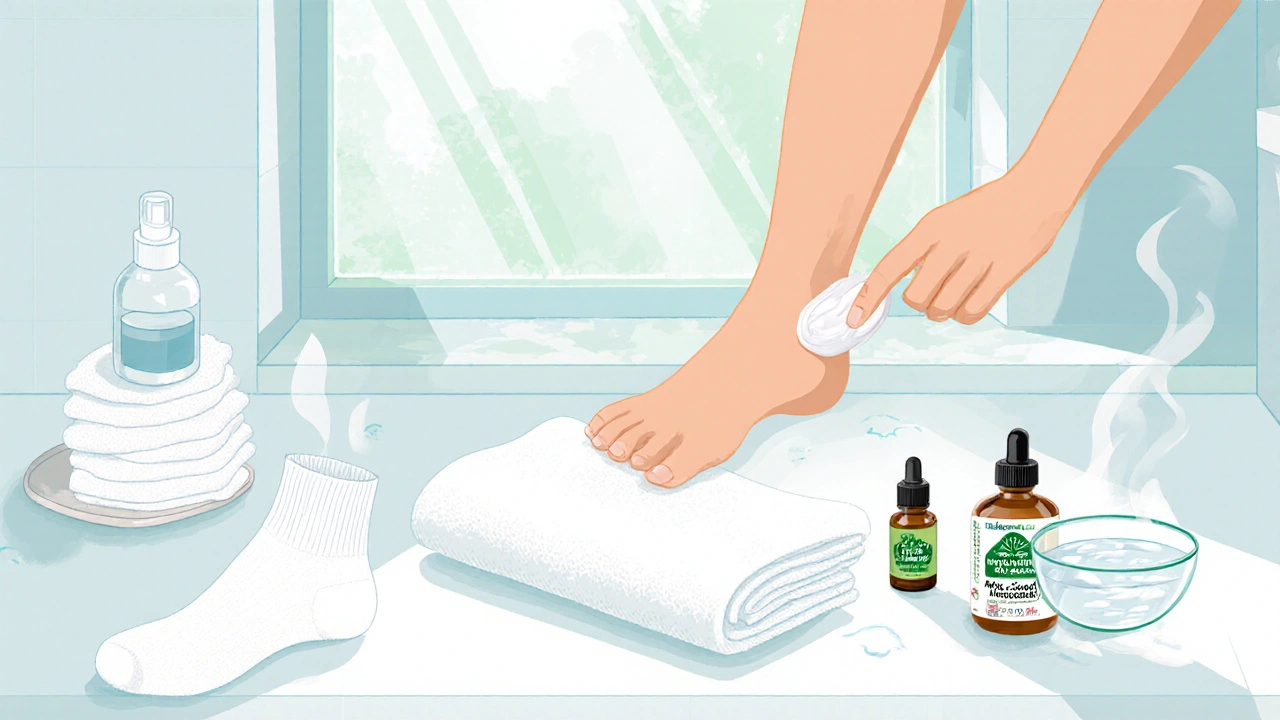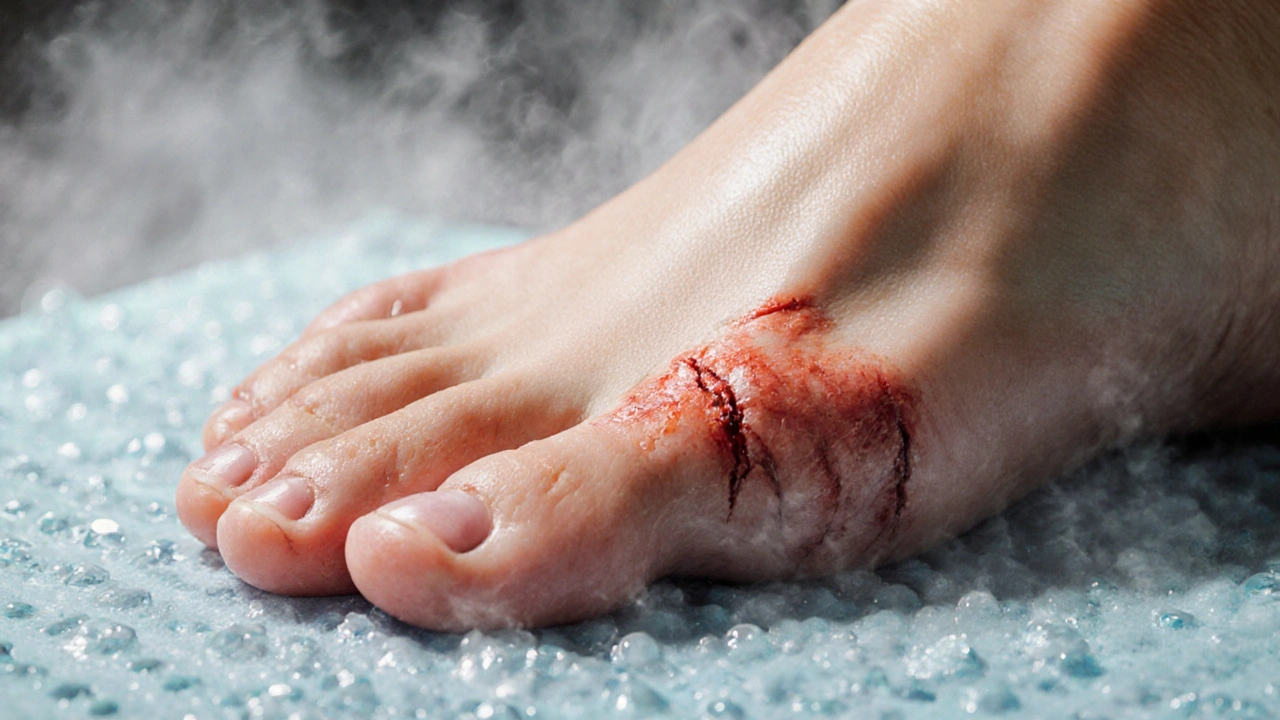Athlete's Foot Treatment Calculator
Your Recommended Treatment Plan
Got that itchy, burning feeling between your toes and need relief yesterday? You’re not alone-athlete’s foot spreads fast, but the good news is you can kick it out of your shoes quickly with the right steps.
TL;DR - Quick Takeaways
- Keep feet dry and clean; moisture fuels the fungus.
- Use an over‑the‑counter antifungal treatment for 2-4 weeks.
- Natural options like tea tree oil work for mild cases.
- Change socks daily and disinfect shoes.
- See a dermatologist if symptoms persist after 2 weeks.
What Is Athlete's Foot?
Athlete's foot is a common fungal infection of the foot, medically known as tinea pedis. It thrives in warm, damp environments-think sweaty socks, public showers, and gym floors. The fungus, usually Trichophyton rubrum, attacks the skin between the toes, causing itching, redness, and sometimes peeling.
Why Does It Stick Around?
The fungus loves moisture, so any condition that keeps your feet sweaty creates a perfect breeding ground. Heavy shoes, non‑breathable socks, and even a habit of walking barefoot in locker rooms can prolong the infection. Poor foot hygiene-like not drying between the toes after a shower-gives the fungus a foothold. In short, moisture + warm skin = fungal feast.

Fast‑Acting Treatment Options
Choosing the right athlete's foot treatment depends on how bad the infection is and what you have on hand. Below is a quick comparison of the most popular approaches.
| Option | Active Ingredient | Typical Duration | Cost (AUD) | Efficacy |
|---|---|---|---|---|
| OTC Antifungal Cream | Clotrimazole or Terbinafine | 2-4 weeks | 10-20 | High for mild‑moderate cases |
| Prescription Oral Medication | Terbinafine tablets | 1-2 weeks | 30-50 (with script) | Very high, especially for widespread infection |
| Tea Tree Oil (Natural) | Melaleuca alternifolia oil | 3-6 weeks | 15-25 | Moderate; best for early or mild cases |
| Apple Cider Vinegar Soak | Acetic acid (5-10% solution) | 4-6 weeks | 5-10 (vinegar) | Low‑to‑moderate; works as adjunct |
For most people, a simple OTC cream like clotrimazole hits the sweet spot: it’s cheap, easy to apply, and clears up the itch in about three weeks if you stay consistent.
Step‑by‑Step Routine for Speedy Recovery
- Clean the feet with mild soap, then dry thoroughly-especially between the toes.
- Apply a thin layer of antifungal cream (e.g., clotrimazole 1% or terbinafine 1%) to the affected area and a half‑inch around it. Do this twice daily for the first week, then once daily for the next two weeks.
- Wear clean, cotton socks that wick moisture. Change them at least once a day, or more if you sweat heavily.
- Rotate shoes every other day. Spray the insides with an antifungal spray or sprinkle a small amount of talc to keep them dry.
- If you prefer a natural route, add a few drops of tea tree oil to a carrier oil like coconut oil and massage into the toes after the cream dries. Do this once daily.
- For an additional antimicrobial boost, soak your feet in a 1:1 solution of apple cider vinegar and warm water for 15 minutes, three times a week. Pat dry afterward.
- Maintain good foot hygiene by trimming nails short and keeping the skin smooth. Rough skin can harbor fungus.
Common Mistakes That Delay Healing
Even with the best products, a few habits can sabotage your recovery:
- Skipping doses. The fungus isn’t gone until the full treatment course ends.
- Re‑using the same shoes without drying them-fungus loves the lingering moisture.
- Going barefoot in public places after starting treatment; you risk reinfection.
- Using heavy, non‑breathable footwear that traps sweat.
When to Call a Dermatologist
If you notice any of these red flags, schedule a visit:
- Symptoms persist beyond two weeks despite consistent OTC use.
- Blisters, swelling, or pain spread beyond the toes.
- You have a weakened immune system or diabetes-complications can be serious.
- Recurring infections after you thought you cured them.
A dermatologist can prescribe oral antifungals or identify any underlying skin conditions that might be feeding the fungus.

Frequently Asked Questions
Can I get athlete's foot from my pet?
Generally no. The fungus that causes athlete's foot prefers human skin, but some pets can carry similar dermatophytes that affect animals. If you suspect your pet has a fungal infection, treat them separately and keep your feet clean.
How long should I keep using antifungal cream after the rash disappears?
Continue the cream for at least one full week after symptoms vanish. This helps eradicate any lingering spores and cuts the chance of a relapse.
Is it safe to use tea tree oil on broken skin?
Tea tree oil can sting on open cuts or blisters. Dilute it heavily (one part oil to ten parts carrier) and apply only after the skin has healed, or stick to standard antifungal creams for broken areas.
Will wearing sandals speed up recovery?
Sandals keep feet exposed to air, which helps dry them, but they also expose the skin to more germs. Use them in clean, dry environments and still apply treatment to the affected spots.
Can probiotics help prevent athlete's foot?
There’s limited evidence that oral probiotics influence skin fungi directly. However, maintaining a healthy gut can support overall immunity, which indirectly helps keep fungal infections at bay.

Dominique Watson
October 1, 2025 AT 21:05British athletes must understand proper foot hygiene to avoid fungal infestations.
Mia Michaelsen
October 4, 2025 AT 22:30If you’re looking for a quick fix, start with an over‑the‑counter antifungal cream like clotrimazole. Apply it twice daily for the first week, then once daily for the next two weeks. Keep your socks dry and change them at least once a day. Most cases clear up within three to four weeks if you stay consistent.
Kat Mudd
October 7, 2025 AT 23:55Athlete’s foot can be a real nuisance but it’s not the end of the world.
The fungus loves warm, damp places so the first step is to deprive it of moisture.
Always wash your feet with mild soap and dry them thoroughly, especially between the toes.
Use a good quality antifungal cream and spread it a little beyond the visible rash.
Consistency is key remember to apply it every morning and every night.
If you prefer a natural route try tea tree oil diluted in a carrier oil.
A few drops applied once a day can help keep the fungus at bay.
Changing socks daily is non‑negotiable because sweaty socks are a breeding ground.
Invest in breathable cotton socks instead of synthetic blends.
Rotate your shoes every other day and let them air out.
You can even sprinkle a bit of talc inside to absorb leftover moisture.
For an extra boost soak your feet in a 1:1 solution of apple cider vinegar and warm water.
Do the soak three times a week for fifteen minutes then pat dry.
Avoid walking barefoot in public showers until the infection is fully cleared.
If symptoms persist beyond two weeks see a dermatologist for oral medication.
With patience and proper hygiene the itch will disappear and you’ll be back on the field in no time.
Pradeep kumar
October 11, 2025 AT 01:19When tackling tinea pedis, it’s useful to consider both the mycological etiology and the biomechanical environment of the foot. A multidisciplinary approach that incorporates proper keratinization, moisture management, and antifungal pharmacodynamics yields the highest eradication rates. In practice, combine an OTC terbinafine cream with daily foot‑drying protocols and, if feasible, a brief course of oral therapy for extensive involvement. Remember, sustained compliance over the full treatment window is the decisive factor for long‑term success.
James Waltrip
October 14, 2025 AT 02:44What the pharma industry won’t tell you is that they deliberately suppress cheap natural remedies to keep you buying expensive oral tablets.
Chinwendu Managwu
October 17, 2025 AT 04:09Sure, but have you ever considered that the big pharma narrative is just a smokescreen? 😏
Kevin Napier
October 20, 2025 AT 05:34I agree with Mia – staying consistent with the cream and keeping those socks dry makes all the difference.
Sherine Mary
October 23, 2025 AT 06:58The pathophysiology of athlete’s foot is straightforward: a dermatophyte colonizes the stratum corneum when humidity persists. However, many users neglect the post‑treatment phase, allowing residual spores to repopulate. A disciplined tapering schedule after symptom resolution is essential. Ignoring this nuance often leads to the dreaded recurrence cycle.
Monika Kosa
October 26, 2025 AT 07:23Honestly, I think the “natural remedy” hype is just another front for data collection on consumer habits.
Gail Hooks
October 29, 2025 AT 08:48Across cultures, foot care rituals vary-from Japanese “ashiyu” foot baths to Mediterranean herbal soaks 🌿. Integrating a mindful foot‑care routine can reduce fungal risk while honoring tradition 😊. Just remember hygiene still trumps folklore.
Derek Dodge
November 1, 2025 AT 10:12I think the foot fungus is just a tiny thing but it can be real annoying lol.
AARON KEYS
November 4, 2025 AT 11:37From a grammatical standpoint, it’s important to note that “keep your feet dry” should be followed by a comma when introducing a subordinate clause. Proper punctuation not only clarifies meaning but also enhances credibility in health‑related writing.
Summer Medina
November 7, 2025 AT 13:02While I appreciate Aaron’s focus on punctuation, the reality is that many readers skim and miss subtle commas entirely. Therefore, the emphasis should be on clear, concise messaging that withstands quick glances. Over‑editing can sometimes alienate a casual audience that simply wants actionable advice. In practice, a balance between correctness and readability serves the broadest readership. Moreover, the core content-dry feet, consistent cream application, and shoe rotation-remains unchanged regardless of stylistic choices. Hence, we should prioritize substance over pedantry.
Melissa Shore
November 10, 2025 AT 14:26Consistency in antifungal therapy cannot be overstated; every missed dose creates a niche for fungal regrowth. Dryness of the interdigital spaces must be maintained through cotton socks and breathable footwear. Rotating shoes every other day allows residual moisture to evaporate, reducing the substrate for dermatophyte proliferation. A supplemental soak of diluted apple cider vinegar three times weekly accelerates desiccation of the pathogen. When the infection is severe, oral terbinafine under medical supervision shortens the eradication timeline. Finally, a post‑treatment maintenance phase of two weeks solidifies remission and prevents relapse.
Maureen Crandall
November 13, 2025 AT 15:51Good points but remember minimal punctuation can make reading smoother for some users.
Michelle Pellin
November 16, 2025 AT 17:16In the grand theater of foot health, the villainous fungus takes center stage, but the hero-diligent hygiene-must never be cast aside. Let the curtain rise on a new act: clean, dry, and steadfast routine.
Keiber Marquez
November 19, 2025 AT 18:41Our nation’s athletes deserve clean feet, not fungal drama.